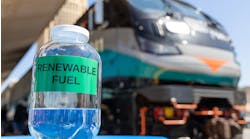Advancing sustainability and efficiency at the Transportation Technology Center through dual-mode motive power
Electrification has been a foundation of sustainable propulsion in the rail industry for over a century. Since the debut of the first electrified rail line in the U.S. 129 years ago, electrification has played a critical role in improving operational efficiency and reducing greenhouse gas (GHG) emissions. Today, as rail systems adapt to modern sustainability goals, dual-mode locomotive technology is emerging as a key solution.
The Transportation Technology Center (TTC) in Pueblo, Colo., operated by ENSCO, is uniquely equipped to support the testing and development of this technology. With dedicated electrified test tracks, advanced testing capabilities and a focus on innovative solutions, the TTC is helping rail operators transition to more efficient and environmentally friendly operations.
The case for dual-mode locomotives
Dual-mode locomotives combine diesel and electric propulsion, offering significant flexibility for rail systems that operate on both electrified and non-electrified tracks. This capability eliminates the need for separate fleets, reducing operational complexity and costs. Operating in electric mode significantly decreases GHG emissions, aligning with sustainability goals. In urban areas, the use of electric propulsion reduces noise pollution, improving the quality of life for communities near rail lines. Additionally, the ability to operate in both modes minimize fuel consumption when in electrified territories, contributing to cost savings and environmental benefits.
This adaptability represents a transformative step toward a greener future for rail transportation. Dual-mode technology integrates with existing infrastructure, accelerating progress toward carbon reduction goals while avoiding the costly, time-intensive process of full network electrification. By bridging gaps in electrified infrastructure, dual-mode locomotives can enable efficient and sustainable operations across diverse rail systems. This approach supports a more inclusive transition to environmentally friendly practices, paving the way for a rail industry that balances efficiency, cost-effectiveness and environmental stewardship.
The Siemens Mobility Charger SC42-DM locomotives exemplify these advancements. Designed to operate on diesel and third rail electricity, these locomotives can enhance operational flexibility and help reduce fleet emissions while meeting growing sustainability demands.
Testing at the TTC
The TTC is the only rail testing facility in the world equipped with both overhead wire catenary and third rail electrification. These unique capabilities make it an ideal location for dual-mode locomotive testing, supporting the development and validation of cutting-edge rail technologies.
The rail transit track loop (RTT), spanning 13.5 miles, supports speeds of up to 165 mph and features adjustable AC overhead wire catenary. The 15-megawatt substation enables voltage adjustment between 12.5 kV and 50 kV AC, accommodating a wide range of testing scenarios. Complementing this is the transit test track (TTT), a 9.1-mile track that includes DC third rail and a two-mile section of DC overhead wire catenary. These configurations replicate real-world conditions for subway, light rail and commuter rail systems, providing a controlled environment for precise and repeatable testing.
The Siemens Mobility Charger SC42-DM locomotives underwent extensive testing on the TTT, specifically to validate their performance under third rail electrification. This rigorous process involved evaluating the transition between diesel and electric modes, verifying third rail contact consistency and assessing performance under varying voltage and load conditions. By simulating real-world operations, the testing ensured that these locomotives met performance and safety standards, giving operators confidence in their capabilities.
The TTC’s specialized infrastructure and expertise were critical in delivering reliable and timely results. Its ability to replicate complex rail environments with precision enabled Siemens Mobility to demonstrate that the Charger SC42-DM locomotives could operate on electrified and non-electrified tracks. This collaboration highlights the importance of comprehensive testing in ensuring the successful deployment of advanced rail technologies. As the rail industry continues to evolve, rigorous validation processes remain essential in bridging the gap between innovative designs and operational success.
Recent developments in dual-mode locomotive technology
In recent years, the rail industry has seen significant advancements in dual-mode locomotive technology, reflecting a growing commitment to operational efficiency and environmental sustainability — with the introduction of Siemens Mobility Charger SC42-DM locomotives being a major milestone. These units are designed to deliver more reliable service while reducing emissions and noise in densely populated urban areas. The adoption of this technology also aligns with regional efforts to modernize transit infrastructure and improve the passenger experience through enhanced performance and dependability.
These developments collectively illustrate a growing industry shift toward adopting dual-mode locomotives to address operational challenges and environmental concerns. Beyond reducing GHG emissions and noise pollution, these locomotives pave the way for a more sustainable rail network by enabling operators to make efficient use of existing infrastructure. As demand for rail travel increases and sustainability becomes a central focus, dual-mode technology is set to play a pivotal role in shaping the future of passenger and commuter rail.
Sustainability and innovation
While dual-mode locomotives are a significant step forward, the potential for innovation in sustainable rail systems extends even further. Battery electric storage systems (BESS) and hydrogen fuel cells represent promising alternatives to diesel engines. Battery-electric locomotives, for instance, can take advantage of regenerative braking and recharge while operating in electrified territories, offering additional energy savings and reduced reliance on external power sources. Hydrogen fuel cell technology, which emits only water vapor, is another potential gamechanger, though it requires substantial infrastructure investment and coordinated industry efforts to achieve widespread adoption.
These technologies could eventually replace diesel components in dual-mode locomotives, creating even more environmentally friendly solutions. However, until these advancements become mainstream, dual-mode technology serves as a practical and impactful transitional solution. By leveraging existing infrastructure and integrating emerging innovations, rail operators can achieve meaningful sustainability gains without incurring the high costs of widespread electrification. This balance between innovation and practicality positions dual-mode locomotives as a bridge to a zero-emissions future.
Industry trends and future outlook
The adoption of dual-mode locomotives is part of a broader trend toward decarbonizing the rail industry. In recent years, rail carriers have explored alternative power options, including batteries, biodiesel and hydrogen fuel cells as pathways to reduce GHG emissions. Battery-electric locomotives offer the promise of emissions-free operations but face challenges related to range, charging times and infrastructure compatibility. Biodiesel, while a cleaner alternative to traditional fuels, depends heavily on the availability of feedstock and its environmental trade-offs. Meanwhile, hydrogen-powered locomotives hold tremendous potential but require significant investments in fueling infrastructure and supply chains.
Despite these challenges, experts believe that zero-emission locomotives could become the norm by the mid 2030s. Dual-mode technology, in the meantime, remains an essential tool for operators balancing sustainability goals with current infrastructure limitations. By reducing emissions, improving operational efficiency and enhancing flexibility, dual-mode locomotives offer a tangible step toward achieving long-term environmental objectives while paving the way for more transformative solutions.
Conclusion
Dual-mode locomotives are a critical component of the rail industry’s transition to more sustainable operations. By combining diesel and electric propulsion, they provide a versatile and practical solution for addressing the challenges of mixed infrastructure and growing environmental demands. Their role as a transitional technology underscores their importance in shaping an industry committed to continuous improvement and innovation.
The TTC, with its state-of-the-art facilities and electrified test tracks, plays a pivotal role in advancing these technologies. From testing dual-mode locomotives to supporting the development of next-generation solutions, the TTC demonstrates how collaborative innovation can drive meaningful change in rail transportation. The expertise and capabilities housed at the TTC enable operators to meet current challenges while preparing for a greener, more efficient future.

Acacia Reber | director of business development
Acacia Reber, MBA, is the director of business development for ENSCO, Inc., which operates the Transportation Technology Center in Pueblo, Colorado.



